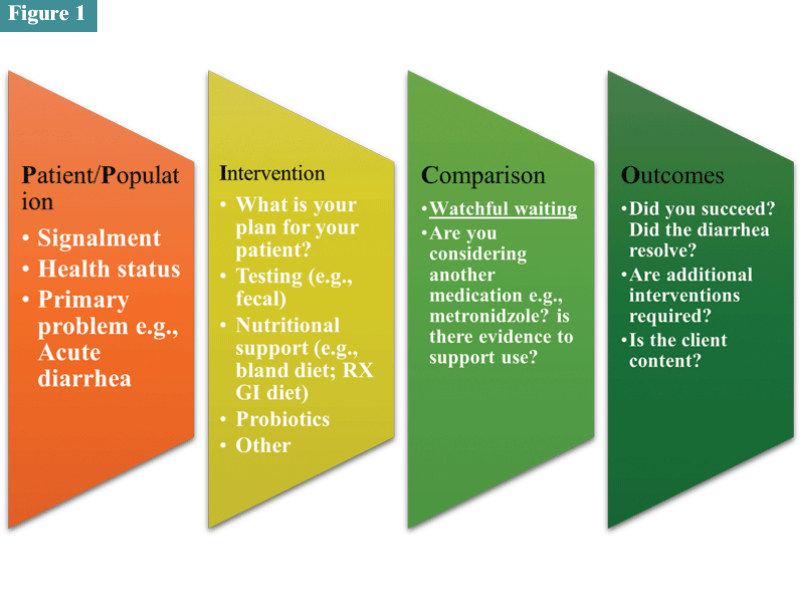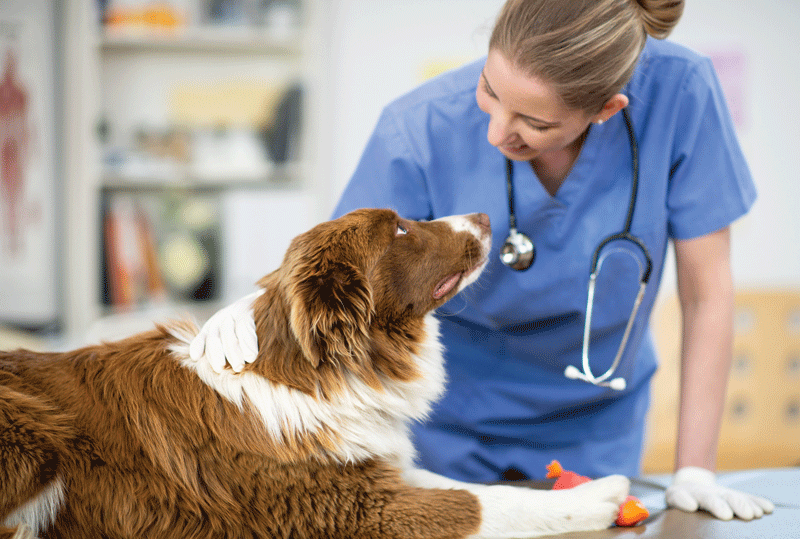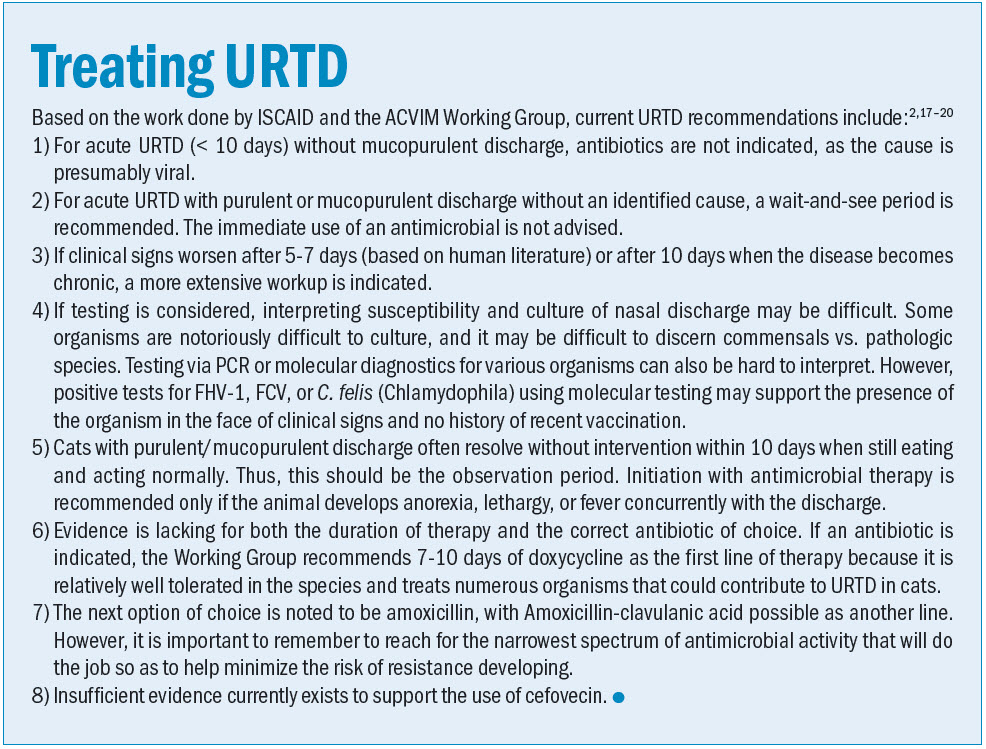
Current research trends in veterinary medicine seek solidifying treatment guidelines, including proper antimicrobial selection and treatment duration for numerous common veterinary conditions. The goal is to ensure veterinarians are not only aware of the evidence, but also to ensure we practice proper antimicrobial stewardship, minimizing the development of antimicrobial resistance (AMR), protecting our patients, and the future health of other animals, people, and the environment.
This One Health approach is paramount to ensuring we continue to have access to critical antimicrobials used in humans and remain able to treat patients armed with evidence-based medicine guiding our choices.
What the evidence supports
Caution is needed when prescribing medications, not just because of the side effect risks and contraindications for an individual patient, but also for the long-term ramifications these medications may have on the animal population, as well as on human and environmental health. Antimicrobial stewardship involves the collective efforts of veterinarians to ensure the continuing efficacy and accessibility of antimicrobial drugs. This is achieved through careful supervision and responsible decision-making to protect the health of animals, the public, and the environment.1
According to the World Small Animal Veterinary Association (WSAVA), increasing the therapeutic effectiveness and avoiding the spread of resistance to antibiotics is crucial. To do this, follow this guide:
- If two medications are equally effective for a certain condition, priority should be given to the drug that poses a lower chance of causing antimicrobial-resistant (AMR) phenotypes.
- Medications not critically important to human medicine should be avoided when feasible. The World Health Organization Advisory Group on Integrated Surveillance of Antimicrobial Resistance (AGISAR) ranks key antimicrobials to permit non-human use risk management.
On-site surveillance and ongoing assessment of both antimicrobial utilization and AMR must be implemented at the clinic level.2,3
Examples
Organizations, such as the International Society for Companion Animal Infectious Diseases (ISCAID) and the Working Group of The American College of Veterinary Internal Medicine (ACVIM), continue to evaluate the evidence and develop updated guidelines for antimicrobials in various clinical settings.
For example, the use of metronidazole in cases of acute diarrhea and antimicrobial use in managing feline upper respiratory tract disease. Recent work has also evaluated the duration of antibiotic therapy warranted for managing aspiration pneumonia.4
When considering an evidence-based clinical query, we can use PICO questions (Population, Intervention, Comparison, Outcome) in treating acute diarrhea in dogs and respiratory tract disease in our feline patients (Figure 1).

The evidence
Treating acute diarrhea in dogs and cats:
PICO: P: Acute diarrhea—is metronidazole (I) warranted in the treatment of acute diarrhea, or is a diet change +/- probiotics sufficient (C) to resolve the majority of cases (O)?5
Whereas previously, metronidazole was prescribed routinely, as with many disease conditions, delayed prescribing (See: “Watchful waiting”) to see if a bacterial disease manifests or if the patient’s body will clear it, is becoming a common expert recommendation.6
Current research shows when compared to simple diet change (+/- probiotics), using metronidazole has no benefit and fails to improve the clinical course. Further, it may cause harm. While it may have anti-inflammatory properties in the GI tract, metronidazole is still an antimicrobial that can negatively impact the microbiome, yet another reason, beyond AMR, not to use antibiotics without due cause and scientifically backed evidence.8-15
Treating respiratory tract diseases in feline patients:
In feline patients with signs of upper respiratory tract disease (URTD) (P), a relevant question is whether an antibiotic, such as azithromycin or doxycycline (I), warranted in the treatment of URI, or is nutritional and hydration support, nasal drops, and related supportive care sufficient (C) to resolve the majority of cases (O).
Feline URTD is associated with signs ranging from sneezing and nasal and ocular discharge to serous and mucopurulent to epistaxis and conjunctivitis. Current evidence supports the majority of these infections are viral in origin (feline herpes–FHV-1 or calicivirus–FCV). Thus, they do not warrant antibacterial therapy. While mucopurulent discharge from various orifices may suggest a bacterial origin, the ACVIM guidelines based on the ISCAID antimicrobial use guidelines have determined this is not a good generalization when considering feline URTD (See “Treating URTD”).
Based on expert recommendations, the first line of treatment for feline URTD should be supportive care, such as nasal drops (saline, neo synephrine), maropitant citrate, and meet nutritional needs. Antibiotics should only be considered when animals fail to improve on their own or develop fever, anorexia, lethargy, or other clinical signs suggestive of bacterial infection.
Uncertainty in veterinary medicine
Evidence continues to evolve. While expert guidelines exist to assist the veterinary community, e.g., as put out by WSAVA, AAFP/AAHA, and the ISCAID, there is still a long way to go. Further evidence that elucidates more clearly when antibiotics are indicated for various conditions is needed, as are more concrete parameters that help guide the antimicrobial selection process and when to use them.
The following resources are beneficial for veterinarians when looking for information on how to apply antimicrobial stewardship in the veterinary field and best practices for the prevention of AMR.6,18,21–23
- ISCAID’s Guidelines and Consensus Statements include antimicrobial guidelines for urinary, respiratory, and dermatological conditions and International and National guidelines.
- How to Practice Antimicrobial Stewardship: The AAFP/AAHA Combined Recommendations.
- The AVMA’s Antimicrobial use in veterinary practice.
- ACVIM’s Recommendations on Treating Respiratory Tract Disease in Dogs and Cats
- ACVIM’s Consensus Statement on Lyme Disease Therapy
The bottom line with current evidence
While our evidence may accumulate slowly, experts have collaborated to establish recommendations based on the currently available evidence. The AAFP/AAHA 2022 guidelines stipulate therapy decisions should be based on available clinical and scientific evidence, and they refer to key references, consensus statements, and guidelines.6
By using the best available evidence, veterinarians can do their part to minimize the development of AMR. Practicing proper antimicrobial stewardship is part of a veterinarian’s duty to the profession and is an important part of the veterinarian’s role in the One Health realm.
Erica Tramuta-Drobnis, VMD, MPH, CPH, is the CEO and founder of ELTD One Health Consulting LLC. Dr. Tramuta-Drobnis works as a public health professional, emergency veterinarian, freelance writer, researcher, and consultant. She is a member of the Evidence-Based Veterinary Medical Association (EBVMA), with different members writing this column. While all articles are reviewed for content, the opinions and conclusions of the author(s) do not necessarily reflect the views of the EBVMA. For information about the association or to join, visit the EBVMA website.
References
- American Veterinary Medical Association (AVMA). Antimicrobial stewardship definition and core principles. American Veterinary Medical Association. Published 2021. Accessed October 21, 2021. https://www.avma.org/resources-tools/avma-policies/antimicrobial-stewardship-definition-and-core-principles
- WSAVA Global Veterinary Council. Key Documents on Responsible Antimicrobial Use and AMR prevention. WSAVA. Accessed February 28, 2024. https://wsava.org/global-guidelines/key-documents-on-responsible-antimicrobial-use-and-amr-prevention/
- World Small Animal Veterinary Association (WSAVA). Antimicrobial Stewardship (AMS) – A must for every companion animal practice. Published May 11, 2020. Accessed April 21, 2024. https://wsava.org/2020/05/11/antimicrobial-stewardship-ams-a-must-for-every-companion-animal-practice/
- Bishop G. Reconsidering antibiotic duration for canine aspiration pneumonia. Veterinary Practice News. Published online March 29, 2024. Accessed April 21, 2024. https://www.veterinarypracticenews.com/evidence-antibiotics-aspiration/?en_click=1&utm_campaign=2024-04-09&utm_medium=email&utm_source=newsletter&utm_content=news&max=VPN-95730
- National Library of Medicine (NLM). Using PubMed in Evidence-Based Practice. Training outreach. Accessed April 21, 2024. https://www.nlm.nih.gov/oet/ed/pubmed/pubmed_in_ebp/02-100.html
- Frey E, Costin M, Granick J, Kornya M, Weese JS. 2022 AAFP/AAHA Antimicrobial Stewardship Guidelines. Published online 2022. https://www.aaha.org/globalassets/02-guidelines/2022-antimicrobial/2022-aafp_aaha-antimicrobial-stewardship-guidelines.pdf
- AAHA (American Animal Hospital Association). Antimicrobial Stewardship Terms and Definitions. AAHA. Accessed April 21, 2024. https://www.aaha.org/aaha-guidelines/2022-aafpaaha-antimicrobial-stewardship-guidelines/antimicrobial-stewardship-terms-and-definitions/
- Shmalberg J, Montalbano C, Morelli G, Buckley GJ. A Randomized Double Blinded Placebo-Controlled Clinical Trial of a Probiotic or Metronidazole for Acute Canine Diarrhea. Frontiers in Veterinary Science. 2019;6. Accessed September 10, 2022. https://www.frontiersin.org/articles/10.3389/fvets.2019.00163
- Stavroulaki EM, Suchodolski JS, Xenoulis PG. Effects of antimicrobials on the gastrointestinal microbiota of dogs and cats. The Veterinary Journal. 2023;291:105929. doi:10.1016/j.tvjl.2022.105929
- Shi N, Li N, Duan X, Niu H. Interaction between the gut microbiome and mucosal immune system. Military Medical Research. 2017;4(1):14. doi:10.1186/s40779-017-0122-9
- Lee D, Goh TW, Kang MG, et al. Perspectives and advances in probiotics and the gut microbiome in companion animals. Journal of Animal Science and Technology. 2022;64(2):197. doi:10.5187/jast.2022.e8
- Schmitz S, Suchodolski J. Understanding the canine intestinal microbiota and its modification by pro-, pre- and synbiotics – what is the evidence? Veterinary Medicine and Science. 2016;2(2):71-94. doi:10.1002/vms3.17
- Rudinsky AJ, Parker VJ, Winston J, et al. Randomized controlled trial demonstrates nutritional management is superior to metronidazole for treatment of acute colitis in dogs. J Am Vet Med Assoc. 2022;260(S3):S23-S32. doi:10.2460/javma.22.08.0349
- Pegram C, Diaz-Ordaz K, Brodbelt DC, et al. Target trial emulation: Do antimicrobials or gastrointestinal nutraceuticals prescribed at first presentation for acute diarrhoea cause a better clinical outcome in dogs under primary veterinary care in the UK? PLOS ONE. 2023;18(10):e0291057. doi:10.1371/journal.pone.0291057
- Scahill K, Jessen LR, Prior C, et al. Efficacy of antimicrobial and nutraceutical treatment for canine acute diarrhoea: A systematic review and meta-analysis for European Network for Optimization of Antimicrobial Therapy (ENOVAT) guidelines. The Veterinary Journal. 2024;303:106054. doi:10.1016/j.tvjl.2023.106054
- Jensen AP, Bjørnvad CR. Clinical effect of probiotics in prevention or treatment of gastrointestinal disease in dogs: A systematic review. Journal of Veterinary Internal Medicine. 2019;33(5):1849-1864. doi:10.1111/jvim.15554
- Weese J s., Giguère S, Guardabassi L, et al. ACVIM Consensus Statement on Therapeutic Antimicrobial Use in Animals and Antimicrobial Resistance. Journal of Veterinary Internal Medicine. 2015;29(2):487-498. doi:10.1111/jvim.12562
- Lappin MR, Blondeau J, Boothe D, et al. Antimicrobial Use Guidelines for Treatment of Respiratory Tract Disease in Dogs and Cats: Antimicrobial Guidelines Working Group of the International Society for Companion Animal Infectious Diseases. J Vet Intern Med. 2017;31(2):279-294. doi:10.1111/jvim.14627
- Brookshire WC, Shivley JM. Antibiotic Stewardship in Canine and Feline Respiratory Infections. Today’s Veterinary Practice. Published June 22, 2021. Accessed April 22, 2024. https://todaysveterinarypractice.com/respiratory-medicine/antibiotic-stewardship-in-canine-and-feline-respiratory-infections/
- Garcia JL. What are the best practices for antibiotic use in feline upper respiratory tract disease? DVM 360. Published August 7, 2017. Accessed April 22, 2024. https://www.dvm360.com/view/what-are-best-practices-antibiotic-use-feline-upper-respiratory-tract-disease
- American Veterinary Medical Association (AVMA). Antimicrobial use in veterinary practice. AVMA. Accessed April 21, 2024. https://www.avma.org/resources-tools/one-health/antimicrobial-use-and-antimicrobial-resistance/antimicrobial-use-veterinary-practice
- International Society for Companion Animal Infectious Diseases (ISCAID). Guidelines and Consensus Statements. ISCAID. Accessed April 21, 2024. https://www.iscaid.org/guidelines
- Littman MP, Gerber B, Goldstein RE, Labato MA, Lappin MR, Moore GE. ACVIM consensus update on Lyme borreliosis in dogs and cats. Journal of Veterinary Internal Medicine. 2018;32(3):887-903. doi:10.1111/jvim.15085


